Tire labeling
Tire labeling overview
The following markings are on the tire in addition to the tire name (sales designation) and the manufacturer's name:
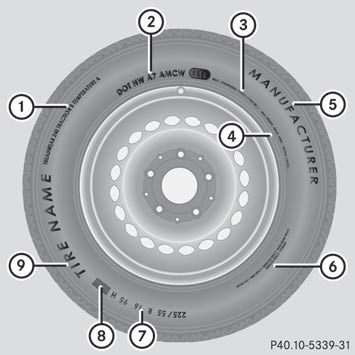
1 Uniform tire Quality Grading Standard
2 DOT, Tire Identification Number
3 Maximum tire load
4 Maximum tire pressure
5 Manufacturer
6 Tire material
7 Tire size designation, load-bearing capacity and speed rating
8 Load index
9 Tire name

Tire data is vehicle-specific and may
deviate from the data in the example.
Tire size designation, load-bearing capacity and speed rating
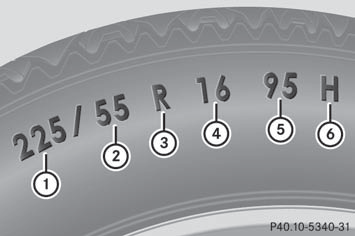
1 Tire width
2 Nominal aspect ratio in %
3 Tire code
4 Rim diameter
5 Load bearing index
6 Speed rating

Tire data is vehicle-specific and may
deviate from the data in the example.
General: depending on the manufacturer's standards, the size imprinted in the tire wall may not contain any letters or may contain one letter that precedes the size description.
If there is no letter preceding the size description (as shown above): these are passenger vehicle tires according to European manufacturing standards.
If "P" precedes the size description: these are passenger vehicle tires according to U.S.
manufacturing standards.
If "LT" precedes the size description: these are light truck tires according to U.S.
manufacturing standards.
If "T" precedes the size description: these are compact emergency spare wheels at high tire pressure, to be used only temporarily in an emergency.
Tire width: tire width 1 shows the nominal tire width in millimeters.
Nominal aspect ratio: aspect ratio 2 is the size ratio between the tire height and the tire width and is shown in percent. The aspect ratio is calculated by dividing the tire width by the tire height.
Tire code: tire code 3 specifies the tire type.
"R" represents radial tires. "D" represents diagonal tires, "B" represents diagonal radial tires.
Optionally, tires with a maximum speed of over 149 mph(240 km/h) may have "ZR" in the size description depending on the manufacturer (e.g. 245/40 ZR 18).
Rim diameter: rim diameter 4 is the diameter of the bead seat, not the diameter of the rim flange. The rim diameter is specified in inches (in).
Load bearing index: load bearing index 5 is a numerical code which specifies the maximum load-bearing capacity of a tire.
 WARNING
WARNING
The tire load rating must always be at least
half of the GAWR of your vehicle. Otherwise,
sudden tire failure may be the result which
could cause an accident and/or serious injury
to you or others.
Always replace rims and tires with rims and tires having the same specifications (designation, manufacturer and type) as shown on the original part.
 WARNING
WARNING
Do not overload the tires by exceeding the
specified load limit as indicated on the Tire
and Loading Information placard on the
driver's door B-pillar. Overloading the tires
can overheat them, possibly causing a
blowout. Overloading the tires can also result
in handling or steering problems, or brake
failure.
Example:
The load bearing index 91 is equivalent to a
maximum load of 1356 lbs (615 kg) that the
tire can carry. For further information on the
maximum tire load in kilograms and pounds.
For further information on the load bearing index, see Load index.
Speed rating: speed rating 6 specifies the approved maximum speed of the tire.
 WARNING
WARNING
Even when permitted by law, never operate a
vehicle at speeds greater than the maximum
speed rating of the tires.
Exceeding the maximum speed for which tires are rated can lead to sudden tire failure, causing loss of vehicle control and possibly resulting in an accident and/or serious personal injury and possible death, for you and for others.
Regardless of the speed rating always observe the speed limits. Drive carefully and adapt your driving style to the traffic conditions.
Summer tires
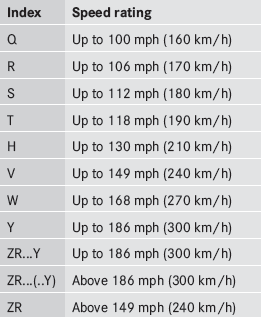
- Optionally, tires with a maximum speed of over 149 mph (240 km/h) may have "ZR" in the size description depending on the manufacturer (e.g. 245/40 ZR 18).
The service specifications consist of load bearing index A and speed rating B.
- If the size description of your tire includes "ZR" and there are no service specifications, ask the tire manufacturer in order to find out the maximum speed.
If a service specification is available, the maximum speed is limited according to the speed rating in the service specification.
Example: 245/40 ZR 18 97 Y. In this example, "97 Y" is the service specification.
The letter "Y" represents the speed rating and the maximum speed of the tire is limited to 186 mph (300 km/h).
- Every tire that has a maximum speed above 186 mph (300 km/h) must have "ZR" in the size description and the service specification must be given in brackets.
Example: 275/40 ZR 18 (99 Y). The speed rating "(Y)" shows that the maximum speed of the tire is above 186 mph (300 km/h).
Ask the tire manufacturer to find out the maximum speed.
All-weather tires and winter tires
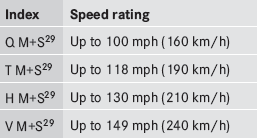

Not all tires that have the M+S
identification offer the driving
characteristics of winter tires. Winter tires
have, in addition to the M+S identification,
the

snow flake symbol on the tire
sidewall. Tires with this identification fulfill
the requirements of the Rubber
Manufacturers Association (RMA) and the
Rubber Association of Canada (RAC)
regarding the tire traction on snow and
have been especially developed for driving
on snow.
An electronic speed limiter prevents your vehicle from exceeding a speed of 130 mph (210 km/h).
The speed rating of tires mounted at the factory may be higher than the maximum speed that the electronic speed limiter permits.
Make sure that your tires have the required speed rating as specified in the "Tires" section (Y page 375), e.g. if you buy new tires.
Further information about reading tire data can be obtained from any qualified specialist workshop, e.g. an authorized Mercedes-Benz Center.
Load index
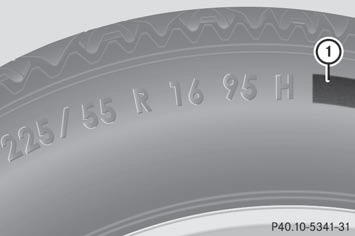

Tire data is vehicle-specific and may
deviate from the data in the example.
In addition to the load bearing index, load index 1 may be imprinted after the letters that identify speed rating 6 on the sidewall of the tire.
- If no specification is given: no text (as in the
example above), represents a standard
load (SL) tire
- XL or Extra Load: represents a reinforced
tire
- Light load: represents a light load tire
- C, D, E: represents a load range that
depends on the maximum load that the tire
can carry at a certain pressure
DOT, Tire Identification Number (TIN)
U.S. tire regulations prescribe that every manufacturer of new tires or retreader has to imprint a TIN in or on the sidewall of each tire produced.
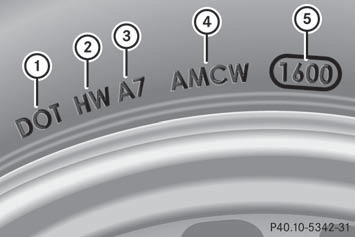
The TIN is a unique identification number. The TIN enables the tire manufacturers to inform purchasers of recalls and other safetyrelevant matters. It makes it possible for the purchaser to easily identify the affected tires.
The TIN is made up of manufacturer identification code 2, tire size 3, tire type code 4 and manufacturing date 5.

Tire data is vehicle-specific and may
deviate from the data in the example.
DOT (Department of Transportation): tire symbol 1 indicates that the tire complies with the requirements of the U.S. Department of Transportation.
Manufacturer identification code:
manufacturer identification code 2 provides details on the tire manufacturer. New tires have a code with two symbols. Retreaded tires have a code with four symbols.
Further information about retreaded tires.
Tire size: identifier 3 describes the tire size.
Tire type code: tire type code 4 can be used by the manufacturer as a code to describe specific characteristics of the tire.
Date of manufacture: date of manufacture 5 provides information about the age of a tire. The first and second positions represent the week of manufacture, starting with "01" for the first calendar week. Positions three and four represent the year of manufacture.
For example, a tire that is marked with "3208", was manufactured in week 32 in 2008.
Tire characteristics
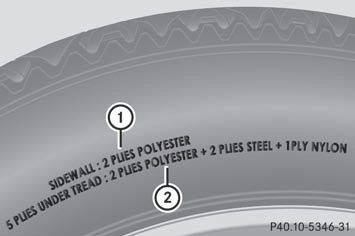

Tire data is vehicle-specific and may
deviate from the data in the example.
This information describes the tire cord and the number of layers in sidewall 1 and under the tread 2.
See also:
Service and vehicle operation
Service and literature
Your vehicle is covered under the terms of the
warranties printed in the Service and
Warranty Information booklet. Your
authorized Mercedes-Benz Center will
exchange or rep ...
Flat tire
Preparing the vehicle
► Stop the vehicle on solid, non-slippery and
level ground, as far away as possible from
traffic.
► Switch on the hazard warning lamps
.
► Apply the parki ...
Lights
Display messages about LEDs:
This display message will only appear if all LEDs have failed.
...
